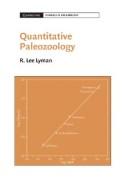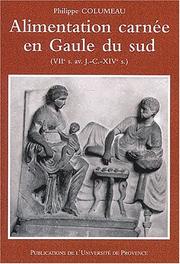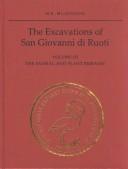| Listing 1 - 5 of 5 |
Sort by
|
Book
ISBN: 9789089640239 9789048506552 9089640231 9048506557 9786612171437 1282171437 9781282171435 661217143X Year: 2008 Publisher: Amsterdam Amsterdam University Press
Abstract | Keywords | Export | Availability | Bookmark
 Loading...
Loading...Choose an application
- Reference Manager
- EndNote
- RefWorks (Direct export to RefWorks)
A detailed analysis of the determination process of various materials made of animal origin
Animal remains (Archaeology) --- Bone implements --- Restes d'animaux (Archéologie) --- Outils d'os --- Science -- Life sciences -- Biological diversity. --- Wildlife products. --- Wildlife utilization. --- Restes d'animaux (Archéologie) --- Archaeozoology --- Zooarchaeology --- Zoology in archaeology --- Archaeology --- Bones --- Animal paleopathology --- Methodology

ISBN: 9780521715362 9780521887496 0521715369 0521887496 9780511813863 9780511384639 0511384637 0511387474 9780511387470 9780511388460 0511388462 9780511386466 051138646X 0511813864 0511382804 9780511382802 1107187117 1281255173 9786611255176 Year: 2008 Publisher: Cambridge : Cambridge University Press,
Abstract | Keywords | Export | Availability | Bookmark
 Loading...
Loading...Choose an application
- Reference Manager
- EndNote
- RefWorks (Direct export to RefWorks)
Quantitative Paleozoology describes and illustrates how the remains of long-dead animals recovered from archaeological and paleontological excavations can be studied and analyzed. The methods range from determining how many animals of each species are represented to determining whether one collection consists of more broken and more burned bones than another. All methods are described and illustrated with data from real collections, while numerous graphs illustrate various quantitative properties.
Animal remains (Archaeology) --- Archaeology --- Paleontology --- Restes d'animaux (Archéologie) --- Archéologie --- Paléontologie --- Methodology. --- Méthodologie --- Restes d'animaux (Archéologie) --- Archéologie --- Paléontologie --- Méthodologie --- Fossilogy --- Fossilology --- Palaeontology --- Paleontology, Zoological --- Paleozoology --- Historical geology --- Zoology --- Fossils --- Prehistoric animals in motion pictures --- Archaeozoology --- Zooarchaeology --- Zoology in archaeology --- Bones --- Animal paleopathology --- Methodology --- Social Sciences --- Archeology
Book
ISBN: 9781623490263 9781623490829 162349026X 1623490820 146194452X 9781461944522 1299938671 9781299938670 Year: 2013 Volume: 18 Publisher: College Station : Texas A&M University Press,
Abstract | Keywords | Export | Availability | Bookmark
 Loading...
Loading...Choose an application
- Reference Manager
- EndNote
- RefWorks (Direct export to RefWorks)
Offering a field-tested analytic method for identifying faunal remains, along with helpful references, images, and examples of the most commonly encountered North American species, Identifying and Interpreting Animal Bones: A Manual provides an important new reference for students, avocational archaeologists, and even naturalists and wildlife enthusiasts. Using the basic principles outlined here, the bones of any vertebrate animal, including humans, can be identified and their relevance to common research questions can be better understood.Because the interpretation of archaeological s
Animal remains (Archaeology) --- Archaeological assemblages --- Taphonomy --- Archaeological surveying --- Restes d'animaux (Archéologie) --- Assemblages archéologiques --- Taphonomie --- Prospection archéologique --- Handbooks, manuals, etc. --- Identification --- Guides, manuels, etc --- Guides, manuels, etc. --- Archéozoologie -- Manuels d'enseignement --- Restes d'animaux (Archéologie) --- Assemblages archéologiques --- Prospection archéologique --- Animal remains (Archaeology). --- Archaeological assemblages. --- Archaeological surveying. --- Archäologie. --- Archäozoologie. --- Excavations (Archaeology) --- Funde. --- Taphonomy. --- Tierknochen. --- Identification. --- Recording --- Recording. --- Archaeozoology --- Zooarchaeology --- Zoology in archaeology --- Archaeology --- Bones --- Animal paleopathology --- Archaeological finds --- Artifact assemblages --- Assemblages, Archaeological --- Antiquities --- Paleontology --- Surveying --- Archaeological digs --- Archaeological excavations --- Digs (Archaeology) --- Excavation sites (Archaeology) --- Ruins --- Sites, Excavation (Archaeology) --- Methodology

ISBN: 2853995178 2821817614 2821827598 9782853995177 Year: 2002 Volume: 29 Publisher: Aix-en-Provence Publications de l'Université de Provence
Abstract | Keywords | Export | Availability | Bookmark
 Loading...
Loading...Choose an application
- Reference Manager
- EndNote
- RefWorks (Direct export to RefWorks)
Ce volume (n° 29 des Travaux du Centre Camille Jullian) fait suite au tome I de l’Animal pour l’Homme « Le monde rural ». Il est centré sur le matériel osseux trouvé lors de touilles urbaines du sud et du sud-est de la Gaule. Il présente à travers l’analyse du matériel osseux animal, les modes d’exploitation des ressources en viande des agglomérations de l’âge du Fer, puis des villes de l’Antiquité romaine et du Moyen Âge. Par l’étude des relations entre l’exploitation alimentaire du bétail et l’histoire des villes, il propose un nouveau regard sur les interrelations entre les principales cités et les campagnes environnantes. Les données de l’archéozoologie sont intégrées dans la restitution du développement et des perturbations des populations anciennes du sud de la Gaule, depuis les habitats indigènes de l’âge du Fer jusqu’aux cités du début du Moyen Âge (jusqu’à l’apparition de la grande transhumance). L’observation des modes d’alimentation carnée et de ses variables apparaît comme un élément novateur de l’approche de l’identité des sociétés anciennes. La relation homme-animal est perçue dans sa dimension économique, mais aussi à travers les manifestations des mentalités, comme culture alimentaire et, à travers elle, de l’ensemble des éléments majeurs de la charpente sociale.
Animal remains (Archaeology) --- Meat --- Food habits --- Primitive societies --- Gauls --- Restes d'animaux (Archéologie) --- Viande --- Habitudes alimentaires --- Homme primitif --- Gaulois --- History --- Food --- Nutrition --- Histoire --- Alimentation --- France --- Gaul --- Gaule --- Antiquities --- Antiquités --- Prehistoric peoples --- Social aspects --- History. --- Anthropology --- Social Sciences --- Manners & Customs --- -Meat --- -Nutrition --- -Prehistoric peoples --- -Cavemen (Prehistoric peoples) --- Early man --- Man, Prehistoric --- Prehistoric archaeology --- Prehistoric human beings --- Prehistoric humans --- Prehistory --- Human beings --- Antiquities, Prehistoric --- Health --- Physiology --- Diet --- Dietetics --- Digestion --- Malnutrition --- Meats --- Food of animal origin --- Eating --- Food customs --- Foodways --- Habit --- Manners and customs --- Oral habits --- -History --- -Health aspects --- Health aspects --- France, Southern --- -Midi (France) --- Occitania (France) --- Occitanie (France) --- South of France (France) --- Southern France --- Antiquities, Roman --- -France, Southern --- -Antiquities, Roman --- -Meats --- Cavemen (Prehistoric peoples) --- Restes d'animaux (Archéologie) --- Antiquités --- Midi (France) --- Antiquities, Roman. --- Méditerranéen (France) --- Meat - Social aspects - France, Southern. --- Food habits - France, Southern - History. --- Nutrition - France, Southern - History. --- Prehistoric peoples - Food - France, Southern. --- histoire de l’alimentation --- archéozoologie --- relations homme-animal

ISBN: 080204865X 9786612033919 1282033913 1442681233 9781442681231 9780802048653 9781282033917 6612033916 Year: 2002 Publisher: Toronto Buffalo University of Toronto Press
Abstract | Keywords | Export | Availability | Bookmark
 Loading...
Loading...Choose an application
- Reference Manager
- EndNote
- RefWorks (Direct export to RefWorks)
This third volume of The Excavations of San Giovanni di Ruoti series deals with the social, economic, and environmental information derived from the analysis of zooarchaeological and palaeobotanical remains found at the fourth-century A.D. Italian villa of San Giovanni di Ruoti. The four contributors use the large collection of organic evidence obtained from the site, including mammal and bird bones, shells, land snails, and plant remains, to provide information on diet, food preparation, economics, trade routes, taxation, local environment and climate, agricultural economy, and animal husbandry. With both technical analysis and an interpretive component, the contributors offer various reconstructions of Roman life, often in combination with "ations from ancient literary sources, allowing this work to appeal to both the specialist and layperson alike. Written with a thoroughness and attention to detail not often seen in zooarchaeological work, this analysis represents an important advance in the study of faunal and botanical data in Roman archaeology in Italy, and will be an invaluable resource for all environmental and classical archaeologists.
Romans --- Excavations (Archaeology) --- Animal remains (Archaeology) --- Plant remains (Archaeology) --- Fouilles (Archéologie) --- Restes d'animaux (Archéologie) --- Restes de plantes (Archéologie) --- San Giovanni di Ruoti Site (Italy) --- San Giovanni di Ruoti (Italie : Site archéologique) --- Country homes --- Ruoti (Italie) --- Antiquités romaines --- Archaeological digs --- Archaeological excavations --- Digs (Archaeology) --- Excavation sites (Archaeology) --- Ruins --- Sites, Excavation (Archaeology) --- Archaeology --- Architecture, Rural --- Rural architecture --- Dwellings --- Park gate lodges --- Ruoti (Italy) --- Italy --- Antiquities, Roman. --- Antiquities --- Fouilles (Archéologie) --- Restes d'animaux (Archéologie) --- Restes de plantes (Archéologie) --- San Giovanni di Ruoti (Italie : Site archéologique) --- Romans - Italy - San Giovanni di Ruoti Site --- Country homes - Italy - San Giovanni di Ruoti Site --- Excavations (Archaeology) - Italy - San Giovanni di Ruoti Site --- Fouilles (Archéologie) - Italie - Ruoti --- Ruoti (Italie) - Antiquités romaines
| Listing 1 - 5 of 5 |
Sort by
|

 Search
Search Feedback
Feedback About
About Help
Help News
News